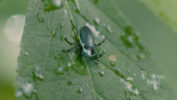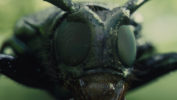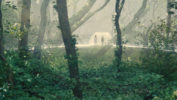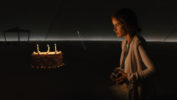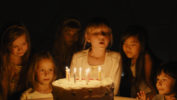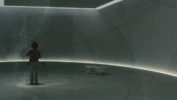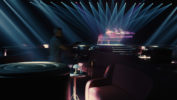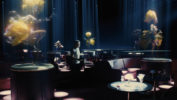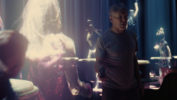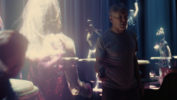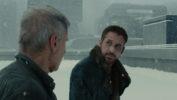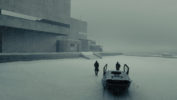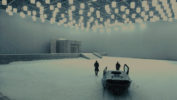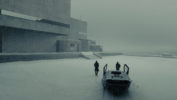BLADE RUNNER 2049
DIRECTOR : Denis Villeneuve
PRODUCTION : Alcon Entertainment
VFX SUPERVISOR : Pierre Buffin / Olivier Cauwet / Jeremy Robert
VFX PRODUCER : Christina Wise / Julien Cimino
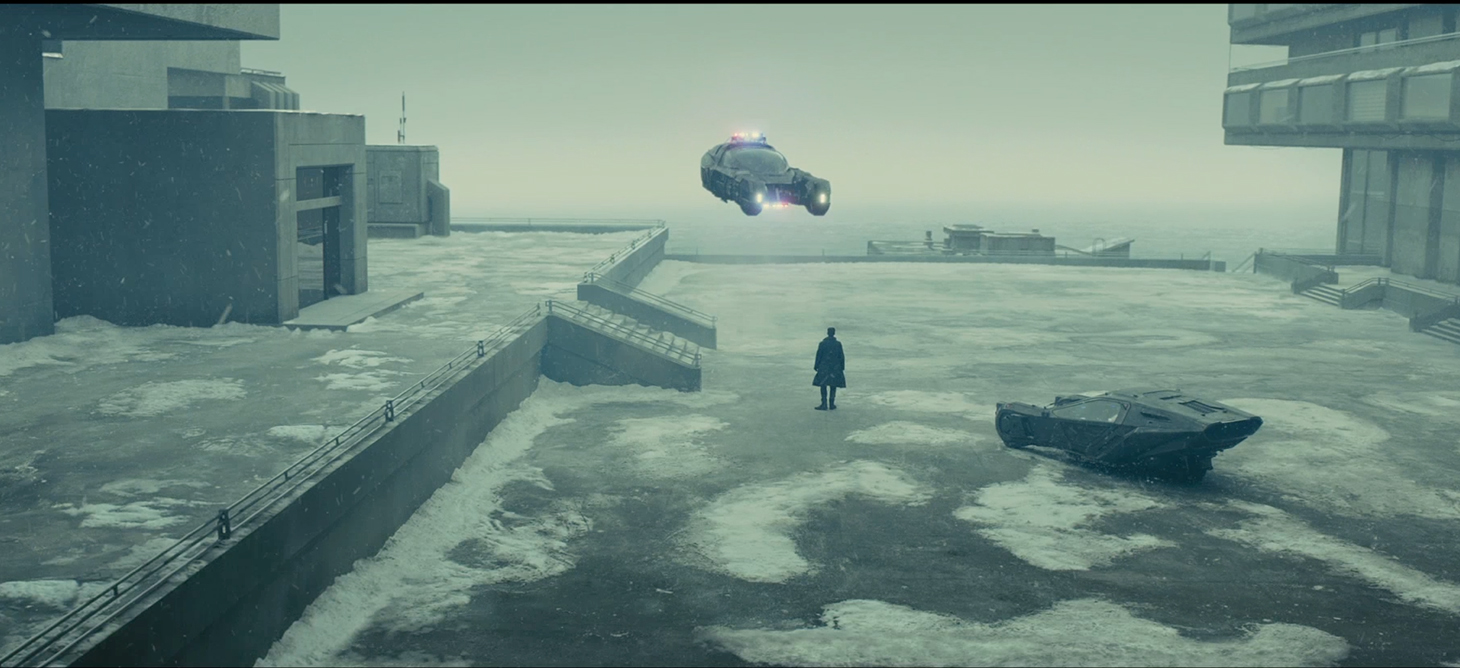
MAKING OF : Charles Labriet
NUMBER OF SHOTS : 107
Awards
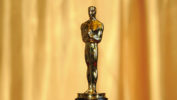 oscars 2018: best visual effects
oscars 2018: best visual effects
Production notes
BLADE RUNNER 2049
In 2016, John Nelson, VFX supervisor, contacted BUF Compagnie for the creation of visual effects on the latest film directed by Denis Villeneuve, "Blade Runner 2049."
BUF was in charge of the preparation, the shooting supervision and the creation of the vfx, on the following sequences:
Holofunhouse
Drink with Frank
Ana’s Memory Lab
Last Stand Off
52 vfx shots, which required the creation of digital doubles (Elvis Presley, Marilyn Monroe, Frank Sinatra), the creation of a hologram show, and the set extension of Los Angeles under snow. 55 VFX shots, which required the creation of CG insects, a forest, and several digital cakes. We also had a shared asset that required minor modification (the police spinner) as well as the creation of set extension for Los Angeles in the snow.
HOLOFUNHOUSE (26 shots)
In Las Vegas, Deckard tracks down Agent K hidden in an abandoned theatre show room. Plunged into the dark, Deckard activates the light show. The system is old and defective, different displays of holograms start and interrupt each other, creating a crescendo of visual chaos.
Shooting:
The sequence was only shot with Harrison Ford and Ryan Gosling.Due to the strong variations of lights, we used LED trackers. All camera positions were marked on the ground, in order to reposition them correctly in the second shoot with the second team. Three days later, with a preliminary reference edit, we went back to the "Holofunhouse" to shoot the 80 dancers (Folie Bergères, Gogo Dancers, Cowgirls) and Elvis' double.The camera was repositioned identically for each shot. In some cases, not having the same equipment as the first team, we have compensated for the big movements of the Supertechnocrane by placing three fixed cameras along the same trajectory. The three views were then morphed to restore the illusion of movement. The holograms being transparent, all layers of dancers were shot separately to avoid overlapping.The lightshow dedicated to each show was recorded by the first team to be replayed with the dancers. It was crucial that the play of lights was identical in both shoots for the integration to work.
Holograms:
To define the look and the disturbances (or glitches) of the holograms, we did a lot of 2D graphic research as well as dozens of 3D tests. We introduced them to John and Denis to define the desired style. The holograms of the Holofunhouse are of an older generation, considered the best of its day but old-fashioned now. Compared to the holograms of 2049, these holograms are what VHS
technology is to BluRay today.For each shot, we have 3D rotoscoped the dancers, in order to convert them into 3D particles. This allowed us to play with the concept of pixels in space. Particles gave us more latitude to
create the hologram effect and its disturbances. The glitch lines can follow the shape of the dancer, and reveal the hidden shape and depth of her body in transparency. Disturbances are temporal glitches, which means a mixture of different positions of the dancer in one image. Other glitches are spatial deformations of the hologram, distortions of the silhouette of the dancers. Even the effects of chromatic shifts are generated in particles, there is almost no 2D effects. The use of our "Neuro" system and our "Blast" scripting language allows us to quickly manage and visualize the effects on particles.
Elvis:
For the creation of the Elvis hologram, we shot the choreography of the double with several cameras, in the same light as the master takes. The double is smaller than Elvis, so we have meticulously 3D rotoscoped to readjust the actor to the proportions of the singer who is much
slimmer in real life. This involved the creation of two complete 3D setups: one for our double and a second for Elvis.
First, we rotoscoped our practical double from the reference footage we shot on set. We then projected this footage frame by frame onto our first 3D model. Next, we used this animation 2and texture data of the first model and reinjected it onto the digital Elvis, or second 3D model. This process was followed to keep the "live" elements we shot practically into the creation of a very accurate or "real" digital Elvis. Because the proportions changed so much, we had to erase the microphone and recreate it in 3D.
For the face of Elivs we referenced hundreds of photo and video documents around the 1970 period.
We have not limited ourselves only to this period. The photos of his youth have focused on the volumes of his face, so specific even to the shape of his ears and the style of his hair. At that time his hairstyle was much shorter and did not hide all these details. We have selected and rotoscoped dozens of photos, in different angles, for the face of Elvis as to be as neutral as possible. It is on this basis that we modeled his face.For his expressions, we have rotoscoped in 3D animation videos of concerts like that of"Suspicious Minds," and "Elvis, That's the way it is, in 1970" to be closer to the performance of Elvis in concert. Same for the backup dancers, he is then converted into a particle to generate the effect ofhologram and glitches that disrupt his performance.
Marilyn:
Marilyn appears only in a fixed shot. It is almost static. Our approach was different. We shot a Marilyn Monroe stand-in on a green background. Then we rotoscoped and adjusted her body to Marilyn's proportions with a 2D warp. For her face, we rostoscoped the face of the stand-in in 3D and mixed Marilyn's characteristic features with the skin color and the expressions of the stand-in.
DRINK WITH FRANK (5 shots)
In Deckard's apartment, K puts a coin in the jukebox and selects Frank Sinatra's song "One For My Baby."A hologram of Frank Sinatra appears in the glass globe of the jukebox.
Shooting:
A transparent and graduated rod is fixed in the place of the hologram in the jukebox. This will make it possible to locate and respect the scale of the hologram in all the shots.
Frank:
The choreography of Frank Sinatra is shot with a stand-in on a green background.Frank Sinatra's hologram is 5x smaller than its actual size and is positioned on the top of the jukebox. It is therefore necessary for each shot to calculate the camera position that will allow us to film the actor in the right perspective once the hologram is reduced and replaced at the height of the jukebox.The stand-in was much more massive than Frank. It was necessary to adjust him by morphing his body to the body of Frank which was much smaller and thinner. We also changed his performance (arm movements) to improve the physical imitation. For the face, we have selected and rotoscoped dozens of photos, in different angles, of Frank's face. It is on this basis that we modeled his face. For the expressions we have rotoscoped in 3D animation the concert "Frank Sinatra - One For My Baby in 1962".
ANA’S MEMORY LAB ( 50 shots )
Dr. Ana Stelline works on the creation of memory images that are implanted in the artificial brains of Replicants. She makes the necessary imagery for an identity profile by manipulating holographic material. A bug on a leaf changes shape, the forest dissipates to make way for Ana's laboratory to be revealed. Officer K has interrupted her in her work. While exchanging a few words with K, Ana continues her art. She is working on a touching moment, a birthday party scene. K leaves Ana and her laboratory and immediately the LAPD arrests him.
Shooting:
The sequence was turned into several stages. The first in early July 2016 : Ana, children and insects were present. The second in October 2016 : Ana and K. At first, we shot a practical forest on set. We started with an establishing shot, followed by the plates we needed for the dissipation effect of the forest. The position of the cameras was measured and documented in order to reproduce these coordinates exactly for the actor shoot a few weeks later. The actors were also filmed with a witness camera in order to refer to Ana in 3D space. A lidar (3D scan) of the forest was made and many reference photographs were taken to help the digital reconstruction of the forest. To facilitate the position of the insects, we placed tracking markers on the practical leaf. Several HDRIs have been shot to help the integration of digital insects. Dead and living insects have been used as a reference. Many photographs were taken, first of all on the film set, for questions of scale, light and texture. Then several more photographs were taken from different angles in order to reconstruct the insects digitally. Video reference was also shot on set to record how insects move. They were very demanding actors. We then went to the studio to shoot the elements of the "birthday party". Detailed plans of the exact position of the different cameras dedicated to the shooting of the shots in this sequence were provided to the production. Each camera setup had to be Ana’s Memory Labrigorously respected for the post production to be of high quality. These camera set ups were determined through a 3D previz based on the storyboards. Each shot depicting the children required between 2 and 4 additional cameras to that of the master camera. Seven cakes were made for the occasion. They were filmed and then scanned in 3D. For each birthday party shot, we referenced the lighting set up and camera position of the master set up. All this information helped in the second stage of filming and post-production.
Insects:
To define the look of the transition between the two insects, we did a lot of 3D visual research and a multitude of tests. We introduced these tests to John and Denis to define the desired transition effect. The shots of the insects ranged from wide to macro. We had to recreate extremely detailed and photo-realistic models. After seeing the work of Professor Javier Alba-Tercador, a Spanish academic based in Granada, the modeling of insects was approached in a less conventional way. Professor Javier Alba-Tercador is doing research on the anatomy of insects using a scanner that can capture micrometric details, such as microscopic hair or the detail of the facets of their eyes. We entered into a collaboration. The data obtained is a sequence of images close to the level of an ultrasound image. Approximately more than 3,000 images were mapped onto planes, sampled with particles, converted into voxels and converted into a 3D model. Our "neuro" proprietary tool, based on our "B.L.A.S.T" language, also developed internally at BUF, allowed us to achieve this extremely precise reconstruction using simple black and white images. After sectioning the model into several pieces, we began construction of a skeleton for animation. Mapping and shading work based on the reference photographs taken during the shoot followed. The transition between insects had gone through several phases. First a 3D morph of each part of the insects migrating from one bug to the other, then different types of wipes, ranging from simple scanning to more complex temporal transitions. The final idea is based on light projection, different spots that make the holographic matter appear or disappear.
Forest:
The disappearance of the forest puts more emphasis on the concept of light projection. The forest disappears like you would see a bank of neon lights shutting down in a corridor that sinks into darkness. Based on a 3D scan recorded on the set, the forest has been fully recreated in 3D to cover the points of view of each of the two shots of disappearance. Many CG elements have been recreated for this effect. More than 200 versions of these shots were made, not only to adjust the overall look, but also for the timing and direction of the effect and how it moves in 3D space. We used "distance" passes, determining the position of one object with respect to another in the 3D space. 3D Mattes were used to remove different sections of forest during the disappearance. This solution has allowed us to have a more flexible approach to the design of the effect. Each iteration could be worked on without having to manage heavy 3D calculations.
Birthday party:
The heart of the sequence, it is at this moment that the work of Ana all makes sense. First of all, we worked on the creation of the different cakes that Ana manipulates. Seven cakes in total, were scanned in 3D on set and then recreated digitally. The difficulty of this section of the sequence was in the realism of the cakes, and essentially the hero cake. The digital hero cake had to perfectly match the practical cake on the party table, and this required very fine adjustments on the specularity and the textures of the icing. The transitions between the cakes were inspired by footage we found online of the luminous decay of an old magnesium flash after it has burned out. Because the reference footage was filmed at a very high speed, we were able to see a light vibration and a hue shift in the decay that became the basis of our transition.
Ana then moves on to organizing and arranging the party.
For the children's shots, we implemented a methodology that would give us the flexibility we needed. Ana must be able to manipulate the images independently in time and space. We opted for a 2D approach. Each shot had to be captured with several cameras. The master camera point of view of the shot, plus 2 to 4 cameras judiciously placed giving us the material and the information useful to the creation of the effect. These additional cameras were arranged in a circle with a radius equivalent to the distance between the main camera and the cake, with an angle not exceeding 35 degrees. The more cameras you have in your set up with this method, the more rotation amplitude (range) you have in your final shot. This technique retains the "analog" feel of shooting without bringing back a "digital" feeling. This solution allowed us to work on the sequence in exact defined steps. At first we adjusted the timing, rotation and acting, in accordance with the editorial cut. Each shot has been modeled with a simple blend and retime from each independent camera. Then we entered the morphing phase to finalize each of the shots. A lot of reconstruction work of the actors has been done to make the rotation as elegant as it is. The sequence had to be strong visually while being poetic and subtle.
LAST STAND OFF (26 shots)
Plaza:
BUF Montreal was in charge of creating the digital set in which Ana's laboratory is located. Anempty and abandoned square lost in the suburbs of LA. Denis had a very clear vision of this place. John guided us with specific designs. A very clear architectural line has been given to us, known as "brutalism." The construction of the different CG elements was done in a very conventional way. This results in a cold and austere digital set. This asset has been shared with our team in BUF Paris for the shots that appear at the end of the film.We also had to finalize the shots that follow the first meeting between Ana and K ... when K leaves the laboratory. To do this we worked with an asset delivered by DNeg, the spinner of policemen who arrests K. Facing the frozen sea, under heavy snow, we have replaced the practical set, using our digital assets of the plaza and composite the Dneg spinner. We also had to rework the spinner to add flashlights and re-shade it while respecting the work of DNeg. The snow on the ground raised by the spinner turbines was simulated digitally, and we also added digital snow in this scene.
End sequences:
Los Angeles, snow and fog cover the city. Deckard and K have a final exchange in front of Dr.Stelline's lab.
For this sequence, the BUF team has created the entire city set which the actors inhabit.It is broken down into 3 main axis: the city of Los Angeles, the laboratory of Dr. Ana Stelline, and the icy ocean with horizon. We presented architectural and atmospheric graphical research to John and Denis.Denis Villeneuve wanted a cold city, made of rough concrete (brutalism). The Director of Photography, Roger Deakins, imagines a white day, a flat sky without details, the city lost in the mist and the snow. The actors are shot in the studio, on a gray background in a smoky atmosphere to diffuse thelight. Artificial snow falls in each take. The buildings that make up the city are modeled and textured according to the proposed designs.A 3D mist, lit by a falling light provides the aspect so particular to concrete buildings in the snow. The editing reveals a concern for continuity, the snow when shooting was more or less dense depending on the shots. We erased the snow in front of the actors and scenery elements, then replaced it with 3D snow. We changed the snow behavior to make it slower and more aerial than was shot practically. The mattes are a real challenge, Deckard's hair is gray, and the snow falls abundantly disrupting the extraction of actors. This required a lot of rotoscoping work.In a concern for continuity in editing, we also managed the amount of flakes on the costumes.Starting from the last shot of the sequence, we went back trhough the sequence, shot by shot,erasing the excess flakes on the collar, hair and shoulders of K and Deckard.



